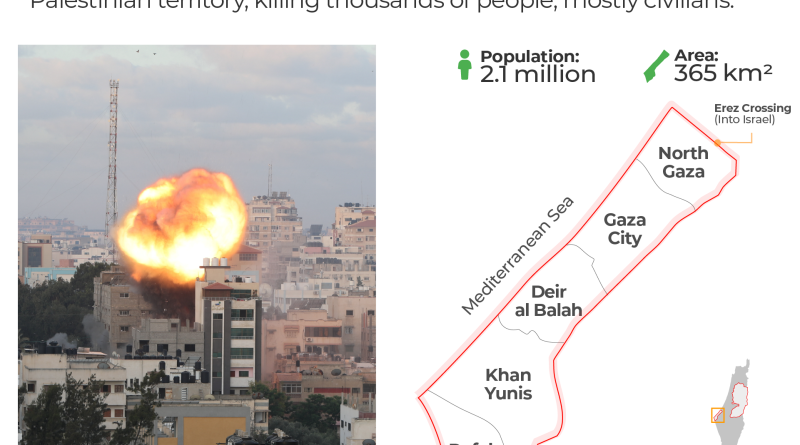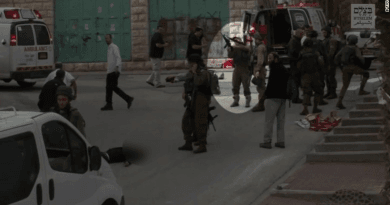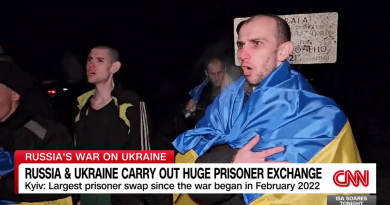Israel Gaza Occupation: Understanding the Ongoing Conflict
The Israel Gaza occupation has reached new heights in 2023, as military actions intensify, leading to significant Palestinian casualties and widespread devastation. Following a series of aggressive strikes designated under the operation “Gideon’s Chariots,” the Israeli military has declared its intention to permanently establish control over critical regions of the Gaza Strip. Reports indicate that these attacks are part of a long-term strategy to weaken Hamas and secure the release of Israeli prisoners. UN agencies have highlighted alarming figures, with at least 250 reported deaths in Gaza within a mere 36-hour span due to the ongoing conflict. As the situation escalates, the international community is witnessing a profound humanitarian crisis that demands urgent attention and action.
In recent months, the situation in the Gaza region has drawn international scrutiny, particularly as Israel seeks to solidify its military presence in this contested territory. The ongoing Gaza conflict has raised serious concerns regarding civilian safety and infrastructure, with reports emerging of extensive damage to hospitals, schools, and homes. With each passing day, the risks for Palestinian civilians grow, as airstrikes continue to increase in frequency and intensity. The narrative surrounding this military engagement reveals deeper historical tensions, characterized by military campaigns aimed at securing strategic advantages. As global observers attempt to grasp the full implications of the Israeli security strategies, the urgency for a peace-driven resolution becomes ever more pressing.
The Intensifying Gaza Conflict of 2023
The Gaza conflict of 2023 has reached unprecedented levels of violence as Israel escalates its military actions in the region. Reports detail extensive aerial assaults and ground operations aimed at defeating Hamas and solidifying control over strategic locations in the Gaza Strip. With the implementation of their latest military plan, dubbed “Gideon’s Chariots,” the Israeli military is not just targeting militant factions but has also inflicted considerable damage on civilian infrastructure, further exacerbating the humanitarian crisis. The toll on Palestinian casualties continues to rise as vast parts of the Gaza Strip are subjected to relentless bombardment.
According to the UN, over 250 individuals have been killed within a mere 36-hour window due to the Israeli military’s increased offensive operations. This alarming statistic highlights the intensity of the current military actions and the devastating impact on the civilian population. The conflict’s complexity is amplified as it unfolds in the backdrop of geopolitical tensions and failed peace negotiations, leading to a profound sense of insecurity and despair among the Palestinian people caught in the crossfire.
Implications of Israel’s Military Action
The implications of Israel’s military action in Gaza are multifaceted, affecting both regional stability and international humanitarian laws. The newly approved assault plan by the Israeli security cabinet indicates a commitment to a long-term occupation strategy, raising concerns among human rights organizations worldwide. International bodies have criticized these actions as potential violations of international law, particularly concerning the protection of civilians during armed conflict.
The systematic nature of these military operations poses significant risks for civilians, particularly in densely populated areas such as the Gaza Strip. The continued escalation of violence not only threatens peace prospects but also can fuel further discontent in the region, leading to a cycle of retaliation and prolonged instability. As the international community observes the rising Palestinian casualties, questions about accountability and the pursuit of justice grow ever more pressing.
Understanding the Gaza Strip Invasion
The term “Gaza Strip invasion” has become synonymous with Israel’s military operations in the region, especially since October 7, 2023. This occupation plan, aimed at controlling key areas, highlights Israel’s strategic interests while neglecting the humanitarian crises unfolding as a result of these actions. The invasion signifies a broader struggle for power involving not only military forces but also the manipulation of public perception and international opinion.
As Israel undertakes these operations, the impact on the people of Gaza is profound. The invasion has led to widespread displacement and destruction, with many Palestinians fleeing to southern parts of the Strip in search of safety. The humanitarian crisis is compounded by blockades that make accessing essential services increasingly difficult. Organizations such as the UN have documented alarming levels of civilian casualties, urging for an immediate cessation of hostilities to allow humanitarian assistance.
Palestinian Casualties and Global Responses
As the violence in Gaza rages on, the Palestinian casualties continue to mount, creating a stark reality for those in the region. Reports following each wave of attacks reveal growing numbers of deaths and injuries, overwhelming hospitals and medical staff who struggle to provide care amidst constant threats. These casualties represent not just numbers but human lives, each with stories and families devastated by the ongoing conflict.
In response to rising casualties and humanitarian concerns, there have been calls from the international community for an immediate ceasefire and intervention. Global leaders and human rights organizations have condemned the disproportionate use of force and the targeting of civilians, demanding accountability from Israel regarding its military strategies. The complicated dynamics of international diplomacy make it essential for world leaders to address these issues decisively, as neglect could lead to further violence and resentment.
The UN Report on Gaza Deaths
Recent reports from the United Nations have highlighted the tragic outcomes of the ongoing conflict, quantifying the loss of life as a critical dimension of the humanitarian crisis in Gaza. The UN’s statistics showing significant Palestinian casualties serve as stark reminders of the ongoing plight faced by civilians amidst military campaigns. Such data is crucial for understanding the scale of the tragedy and the urgent need for international action to halt the violence.
The UN’s findings also emphasize the dire conditions resulting from Israel’s military actions and the need for increased humanitarian assistance. The reports call for immediate attention to those affected by the bombing campaigns, urging international leaders to prioritize peace efforts and cease hostile actions. The acknowledgment of Gaza’s suffering through impartial reports can help mobilize global support and facilitate dialogues aimed at conflict resolution.
Permanent Occupation: A Historical Perspective
Understanding the concept of permanent occupation within the context of the Gaza conflict requires a historical lens. Israel’s strategy to expand its control over Gaza has roots that can be traced back through decades of geopolitical tensions and territorial disputes. Historical precedents of occupation raise complex questions about sovereignty, rights of displaced Palestinians, and the implications for peace in the region.
As Israel proceeds with its latest military strategy, the notion of permanence in occupation suggests an enduring status quo that can limit hopes for a peaceful resolution to the conflict. Previous attempts at negotiating peace have often faltered, leading to a cycle where military might is employed as a tool of policy, overriding diplomatic efforts aimed at achieving lasting stability and justice for all sides involved.
Geopolitical Tensions Influencing the Gaza Conflict
The Gaza conflict is deeply influenced by broader geopolitical tensions that shape the strategic calculations of Israel and neighboring states. International relations, especially with key players like the United States, play a pivotal role in the dynamics of the conflict. The unwavering support from certain countries bolsters Israel’s military actions, often sidelining humanitarian concerns, thus exacerbating the suffering of the Palestinian population.
Furthermore, the changing landscape of global politics, especially with rising powers and shifting alliances, adds layers of complexity to the situation. Regional actors may utilize the conflict to serve their interests, while the aspirations of Palestinian self-determination remain overshadowed amid international rivalries. This web of geopolitical influences not only prolongs the conflict but also complicates the path toward achieving a sustainable peace in the region.
Humanitarian Crisis Resulting from Escalating Violence
The escalating violence in Gaza has precipitated a humanitarian crisis of alarming proportions. With infrastructure decimated by airstrikes, access to food, clean water, and medical care has dwindled dramatically. The plight of those caught in the conflict is becoming more dire, as humanitarian organizations struggle to deliver aid amidst hostilities, leading to calls for an immediate ceasefire and intervention.
The worsening conditions have drawn international attention, with many urging the global community to take action to alleviate the suffering of the Palestinian people. Humanitarian crises like this demand a concerted response that addresses the immediate needs of civilians while also seeking to resolve the underlying issues that perpetuate the cycle of violence. Only through concerted efforts can steps be taken to provide relief and work towards durable solutions that foster long-term peace.
The Role of International Law in the Gaza Conflict
International law plays a crucial role in framing the responses to the Gaza conflict and guiding the actions of states in armed conflicts. The ongoing military actions by Israel raise significant legal questions concerning the principles of proportionality and distinction, which mandate the protection of civilians during warfare. Observers and legal experts have increasingly scrutinized the Israeli military’s operations through this lens to assess compliance with international humanitarian law.
The application of international law is essential for holding accountable those responsible for violations amidst the chaos of armed conflict. Ensuring that parties do not act with impunity is vital for achieving justice for the affected populations and restoring faith in international legal frameworks. As discussions around accountability gain momentum, the international community grapples with how best to apply legal standards that protect human rights while navigating the complex realities of the conflict.
Frequently Asked Questions
What is the current situation regarding Israel’s military action in Gaza?
Israel’s military action in Gaza has intensified significantly since October 2023, following the approval of plans by the Israeli security cabinet to expand and solidify its occupation. The Israeli army has launched extensive attacks aimed at defeating Hamas, which they claim is necessary for security and stability.
How many Palestinian casualties have been reported during the Gaza conflict in 2023?
The Gaza conflict in 2023 has resulted in significant Palestinian casualties, with reports indicating at least 250 deaths within a short period due to intensified Israeli attacks. The ongoing military operations are contributing to a high toll among civilians.
What is the purpose of the Israeli military’s operation dubbed ‘Gideon’s Chariots’ in Gaza?
The operation ‘Gideon’s Chariots’ is part of Israel’s broader strategy to achieve military objectives in Gaza, primarily aimed at defeating Hamas and securing the return of Israeli prisoners. This operation has been characterized by extensive ground assaults and is viewed as a step toward a permanent occupation.
What does the UN report say about Gaza deaths during the latest military action?
According to recent UN reports, at least 250 individuals have been reported killed in Gaza within a span of 36 hours as a direct consequence of Israeli military actions. This has raised concerns about the humanitarian impact of the conflict.
Is there a risk of forced relocation of Palestinians in the Gaza Strip due to the ongoing occupation?
Yes, there are significant concerns regarding the forced relocation of Palestinians within the Gaza Strip. Israeli officials have indicated that their military strategy may involve relocating displaced Palestinians to the southern parts of Gaza as part of their plans to ensure a permanent occupation.
What do reports indicate about Israeli military strategy in the Gaza Strip moving forward?
Reports indicate that the Israeli military strategy will focus on not retreating from areas captured during the ground assaults, reinforcing the intention of a prolonged occupation of the Gaza Strip. This approach marks a shift from previous operations where territorial withdrawal was more common.
How are civilian infrastructures affected by Israel’s military actions in Gaza?
Israel’s military actions have notably affected civilian infrastructure in Gaza, with reports highlighting damage to schools, hospitals, and homes. Airstrikes have directly targeted these essential structures, exacerbating the humanitarian crisis amid the ongoing conflict.
What phases are outlined in the Israeli assault plan for the Gaza Strip?
The Israeli assault plan consists of three phases, with the first phase involving initial preparations and the second phase focusing on intensified attacks and potential displacement of Palestinians if no ceasefire is achieved. This strategic outline raises concerns regarding the implications for human rights in Gaza.
| Key Point | Details |
|---|---|
| Israeli Army’s Plan | The Israeli army announced the implementation of a plan to expand and make the occupation in Gaza permanent. |
| Operations Code Named | ‘Gideon’s Chariots’ aimed to defeat Hamas and retrieve Israeli prisoners, with significant attacks continuing. |
| Civilian Casualties | UN reported at least 250 deaths in Gaza within 36 hours due to intensified Israeli attacks. |
| Targeting Infrastructure | Schools, hospitals, and civilian infrastructures were heavily targeted during the assault, affecting thousands of displaced Palestinians. |
| Approval of Assault Plan | The Israeli security cabinet approved the structure of a three-phase assault plan to solidify the occupation. |
| Future Actions | Continued military presence in captured areas, with no plans for retreat. |
Summary
The Israel Gaza occupation refers to the ongoing military actions and policies aimed at establishing a permanent Israeli presence in Gaza, which has led to significant loss of life and humanitarian crises. The recent actions by the Israeli army mark a troubling escalation in the occupation of Gaza, with widespread attacks resulting in civilian casualties and infrastructure destruction. As the situation develops, the implications for both Palestinians and regional stability remain profound.




